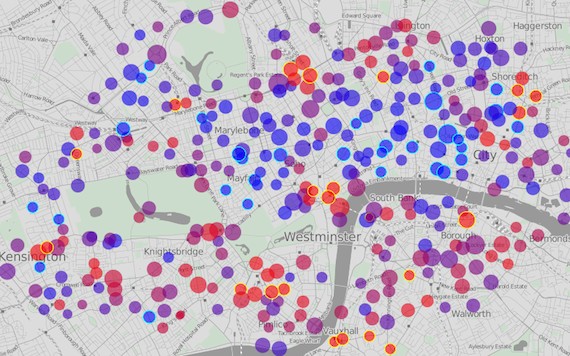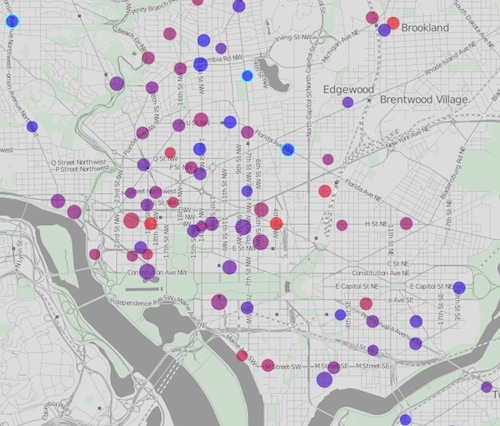
A fantastic new visualization of 16 bike-share systems around the world lets you see how people are using public bikes from London to Melbourne. You can watch animated graphics, for example, of bikes getting picked up in one part of town and dropped off in another during rush hour. The site, created by Oliver O'Brien, a researcher at University College London, also lets you compare bike-share usage from city to city.
While a few American cities have made big strides in bike-sharing this year, with Denver, Minneapolis, and Washington D.C. all committing to systems with 500 or more bikes, O'Brien's site indicates that people aren't using them very much. These systems occupy a middle ground between totally impractical pilot projects and the more robust bike-share networks that have recently sprouted in major European and Asian cities. For bike-sharing to take off here, improvements like increased station density, better bike infrastructure, and interoperability with transit systems will probably be necessary.
In cities with large-scale systems and densely clustered stations, huge numbers of people get around on shared bikes. For example, as of 1:30 p.m. yesterday afternoon (Eastern Standard Time), 1,342 bikes were checked out from Barcelona's Bicing system. At the day's peak point, 2,425 Bicing bikes were in use all at once, out of a total of around 5,000.
In contrast, D.C.'s new Capital Bikeshare program had only 23 bikes out at 1:30, with 50 in use at the day's peak. Nice Ride in Minneapolis had only five bikes in use, with a high for the day of 26. The two systems had a total of 648 and 588 shared bikes at all of their stations, respectively. Over the course of the day, that adds up to fairly marginal ridership. Denver's usage rates, too, were quite low.
So what's standing in the way of American bike-share success? One factor offered by bike-sharing consultant Paul DeMaio is that Americans need some time to get used to bike-sharing. D.C.'s system is just a month old today, he noted, and not even fully built out, while Denver's opened in the spring and Minneapolis's in the summer. That said, London's Barclays Cycle Hire system launched at the end of July, but yesterday had a high of 815 bikes in use at once, according to O'Brien's site.
"Enough cannot be said about scale," said Michael Kodransky, a research associate with the Institute for Transportation and Development Policy. "Station density is key."

The more places to pick up and drop off a shared bike, the closer people can get to their ultimate destinations, and the more useful the system will be for riders.
Paris's Vélib system has 20,000 bikes at 1,450 stations, with stations an average of 300 meters apart in the city center. As Greater Greater Washington has noted, for D.C. to reach that level of bike-sharing saturation, it would need around 5,400 bikes in its system. That's an order of magnitude more than what the system provides today.
DeMaio agreed that increased station density would greatly boost bike-sharing ridership and called on government -- federal, state, and local -- to help fund full-scale programs. The D.C. area applied for a TIGER II grant to add 3,000 more bikes to its bike-share program, he said, but learned yesterday that it wasn't picked as a winner.
Kodransky also highlighted the importance of interoperability between mass transit and bike-sharing systems. "In Paris, you use the Navigo card on mass transit and then when you get off, you slap it on the bike-sharing station and ride," he explained. That makes bike-sharing feel as integrated with transit as, say, New York City's subways and buses.
Finally, Kodransky said that many American cities lack the well-developed bike infrastructure that other cities boast, which keeps people off bikes, shared or otherwise.
Bike-sharing has the potential to be a game-changer for cycling in American cities, if we get it right. But if ridership remains anemic because the system is too spread out, the lack of use will become an arrow in the quiver of bike-share critics. Incremental progress can be made, of course -- Capital Bikeshare was preceded by the pilot program SmartBike DC, which only had 10 stations and an average of 77 to 163 total trips per day -- but as London is showing right now, starting off big is the best way to prove the concept works.





